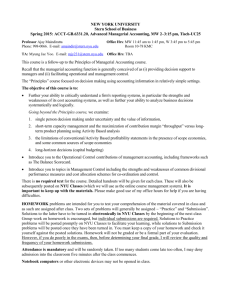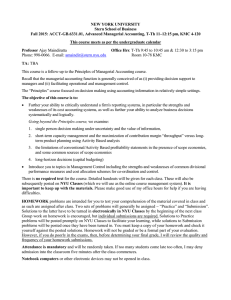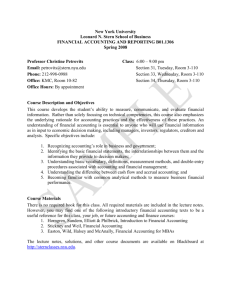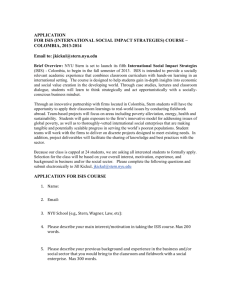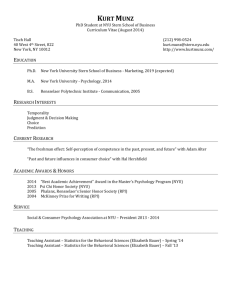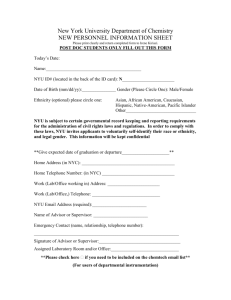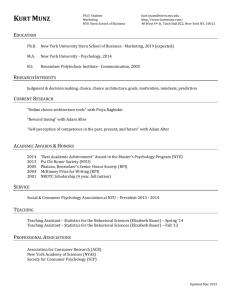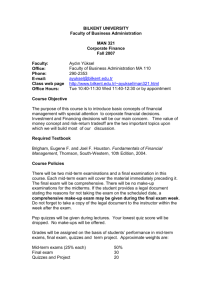C30.0011 Economics of Global Business (EGB)
advertisement
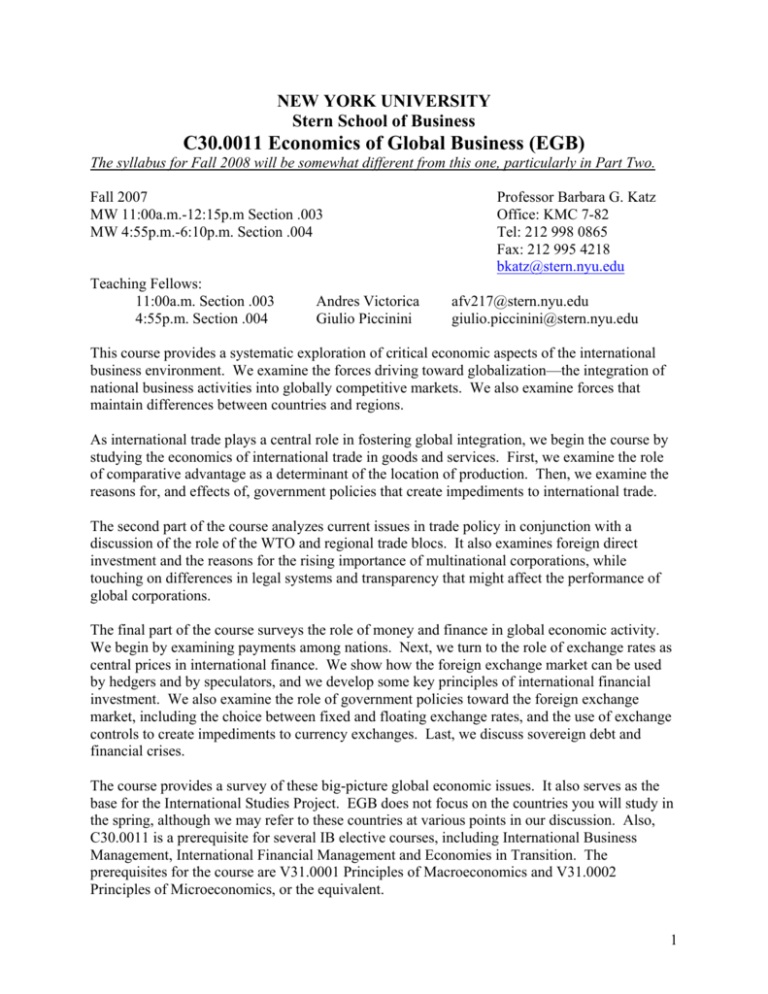
NEW YORK UNIVERSITY Stern School of Business C30.0011 Economics of Global Business (EGB) The syllabus for Fall 2008 will be somewhat different from this one, particularly in Part Two. Fall 2007 MW 11:00a.m.-12:15p.m Section .003 MW 4:55p.m.-6:10p.m. Section .004 Teaching Fellows: 11:00a.m. Section .003 4:55p.m. Section .004 Andres Victorica Giulio Piccinini Professor Barbara G. Katz Office: KMC 7-82 Tel: 212 998 0865 Fax: 212 995 4218 bkatz@stern.nyu.edu afv217@stern.nyu.edu giulio.piccinini@stern.nyu.edu This course provides a systematic exploration of critical economic aspects of the international business environment. We examine the forces driving toward globalization—the integration of national business activities into globally competitive markets. We also examine forces that maintain differences between countries and regions. As international trade plays a central role in fostering global integration, we begin the course by studying the economics of international trade in goods and services. First, we examine the role of comparative advantage as a determinant of the location of production. Then, we examine the reasons for, and effects of, government policies that create impediments to international trade. The second part of the course analyzes current issues in trade policy in conjunction with a discussion of the role of the WTO and regional trade blocs. It also examines foreign direct investment and the reasons for the rising importance of multinational corporations, while touching on differences in legal systems and transparency that might affect the performance of global corporations. The final part of the course surveys the role of money and finance in global economic activity. We begin by examining payments among nations. Next, we turn to the role of exchange rates as central prices in international finance. We show how the foreign exchange market can be used by hedgers and by speculators, and we develop some key principles of international financial investment. We also examine the role of government policies toward the foreign exchange market, including the choice between fixed and floating exchange rates, and the use of exchange controls to create impediments to currency exchanges. Last, we discuss sovereign debt and financial crises. The course provides a survey of these big-picture global economic issues. It also serves as the base for the International Studies Project. EGB does not focus on the countries you will study in the spring, although we may refer to these countries at various points in our discussion. Also, C30.0011 is a prerequisite for several IB elective courses, including International Business Management, International Financial Management and Economies in Transition. The prerequisites for the course are V31.0001 Principles of Macroeconomics and V31.0002 Principles of Microeconomics, or the equivalent. 1 Course Materials Required textbooks: Thomas Pugel, International Economics. New York: McGraw-Hill/Irwin, Thirteenth Edition, 2007. (Abbreviated P) Thomas L. Friedman, The World Is Flat (Updated and Expanded): A Brief History of the Twenty-First Century. New York: Farrar, Straus and Giroux, 2006. (This book is to be read during the first half of the semester.) I strongly suggest that you read (perhaps quickly) the assigned reading before the class discussion of the topic. In the class discussion I will usually cover the concepts and issues that are most challenging, reinforcing and extending what is in the required reading. I suggest that after the class session you review the assigned reading to solidify your understanding. It is important that you develop the ability to use and apply the concepts and tools developed in the course. The best way to do this is to practice actively outside of the class sessions. Questions and problems in the textbook are an excellent source of practice items, and I urge that you complete them. If an entire chapter is assigned as required reading, then all questions and problems at the end of this chapter are relevant. If only a part of a chapter is assigned as required reading, then the course outline indicates the relevant questions and problems. In addition, several problem sets will be distributed. The problem sets need not be handed in; rather, suggested answers will be distributed. I urge you to do these problems. One way to get actively involved with this material is to work with a few other people in the class (informal student study groups) to discuss the questions and problems in the textbook as well as the problem sets. Sessions conducted by the teaching fellows will be arranged to go over the assigned homework problems. Copies of the course notes that will be used in the class sessions will be distributed in class. In addition, you will receive a handout in each session providing a roadmap for the discussion of that class, as well as a summary of the previous class. If you have to miss a class, you will be able to get a copy of the handouts from the Backboard web site (see below). It is highly recommended to keep up with current developments in the international business environment, both for class purposes and for your own benefit. You can do this by reading the relevant articles in a good newspaper (e.g., Financial Times, Wall Street Journal, New York Times) or weekly magazine (e.g., The Economist). You are encouraged to bring up current events for discussion in class, as time permits. Blackboard Web Site I will maintain a web site for the course using Blackboard: http://sternclasses.nyu.edu. On the web site you will find announcements as well as downloadable files with nearly all class handouts. Please check the Blackboard site frequently. 2 Course Requirements The course grade will be based on the following items, with weights indicated: First mid-term examination Second mid-term examination Final examination Participation (quality more than quantity) 28% 28% 38% 6% The coverage and expected dates for the exams (note, there are 28 class sessions): First mid-term examination: Covers Part One, October 17 (12th class; Wednesday). Second mid-term examination: Covers Part Two, November 12 (19th class; Monday). Final examination: Cumulative, with emphasis on Part Three, December 14, 12p.m.1:50p.m. (Friday, during final exam week) All examinations must be taken on the date they are given; there will be no “make-up” exams. Please note that there is a common final exam time (not a common exam) for all EGB sections: Friday, December 14, from 12pm-1:50pm. It is NOT the usual time assigned by the University for the class time-slot. The exam room will be announced in class. Evaluation of Written Work Many of you will find the exams difficult. My goal in creating an exam is to provide you with a substantial challenge. I am not “out to get you,” but I am out to see how far you can go with the material. The best answers to exam questions often are based on the abilities: • • • • • To apply concepts and tools, To use judgment, To develop new insights that you have not seen before the exam To make connections to find the most relevant concepts and tools to use in your answers To answer the question that is asked, not some other question. Accomplishing all of this is not easy. I hope that many of you will succeed, and would be delighted if all of you do. At the same time, an agreed distribution (35% A and A-; 55% B+, B, and B-; 10% C+ and below) serves as the guideline for the distribution for grades for the course. Students with Disabilities If you have a qualified disability and will require academic accommodation during this course, please contact the Moses Center for Students with Disabilities (CSD, 998 4980) and provide me with a letter from them verifying your registration and outlining the accommodations they recommend. If you will need to take an exam at the CSD, you must submit a completed Exam Accommodations Form to them at least one week prior to the scheduled exam time to be guaranteed accommodation. 3 Responsibilities I presume that we are all adults. There are several implications of this: • • • • • As the teacher I have the responsibility to organize and present the material and to facilitate your learning. As a student you have responsibility for your own learning. Honor Code: I expect you to adhere to the Undergraduate Code of Conduct. No lying, cheating, or plagiarism of published work, work posted on the web, or work done by other students will be tolerated. Any suspected case will be referred to the School’s student discipline committee. Actions that have negative effects on others will not be tolerated in the classroom. All class sessions are important, and I expect you to attend each class. If you cannot attend, please let me know in advance. If you must arrive late or leave early, you must do so as quietly as possible. No cell phones should be audible during class sessions. Contacting Professor Katz I will usually be available for quick questions in the classroom during the several minutes before or after the class session. My office hours will be 3:30-4:30 p.m. Monday and Wednesday. You may also contact me to arrange a mutually agreeable time to meet. You may also drop by my office — if I am there, I can usually make some time to talk with you. My office is Room KMC 7-82. My telephone is 212-998-0865. My fax is 212-995-4218. My e-mail is bkatz@stern.nyu.edu. I usually respond quickly to e-mail messages, so this is an excellent way to contact me. Teaching Fellows Each section of the class has a second-year MBA student as the teaching fellow (TF) for the class: Section .003 Andres Victorica afv217@stern.nyu.edu and Section .004 Giulio Piccinini giulio.piccinini@stern.nyu.edu. The TF will usually be available to talk with you briefly in the classroom during the several minutes before the class session begins and after it ends. The TF will also have office hours and a homework problem session each week, time and place to be announced. You can also contact the TF by e-mail with questions or to arrange a mutually agreeable time to meet. Laptop Policy I strongly prefer that you do not use your laptops in class. You will be given a pack of lecture notes, and can take additional notes, as necessary on them. 4 Topical Organization PART ONE: INTERNATIONAL TRADE IN GOODS AND SERVICES 1. Introduction: International linkages, globalization International economic transactions: Trade in goods and services, income payments, foreign direct investment, international financial flows Globalization Improvements in communications and transportation Diffusion of information: Mass media, internet Required reading: P, Chapter 1 (Hint: Skim P, Chapter 2 to review basic concepts) Audio: Thomas L. Friedman: Globalization 2. Free trade, comparative advantage, and locating production Commodity (product) pattern of trade The economy as a set of industries or products Comparative advantage Differences in technology or resource productivity: Ricardo Differences in factor resource availability: Heckscher-Ohlin Effects of international trade National net gains Winners and losers International factor price equalization Intraindustry trade, product differentiation and economies of scale Growth in one factor Required reading: P, Chapters 3, 4, 5, and 6, pp. 109-113 (top), Case Study p. 114, and pp. 119-123. (Relevant Questions and Problems on pp. 125-126 are 2, 5, 6 and 7.) 3. National government policies toward international trade Import protection (tariffs, quotas, other nontariff barriers) Effects of import protection Arguments for import protection Required reading: P, Chapter 8, pp. 147-168, and Chapter 10. (You may also skim Chapter 2 to review the basic analysis of free trade using demand and supply of a product, before you begin reading Chapter 8.) (Relevant Questions and Problems on pp. 176178 are 1, 2, 3, 4, 5, 7, 8, 9, and 11.) First mid-term exam: Oct. 17, 2007 (12th class) 5 PART TWO: CURRENT ISSUES IN TRADE POLICY AND FOREIGN DIRECT INVESTMENT 1. Contentious issues in trade policy Dumping and antidumping duties Export subsidies and countervailing duties Required reading: P, Chapter 11. 2. International institutions: World Trade Organization and regional trade blocs Principles and activities of the WTO Trade discrimination: Free trade area, customs union, common market, and economic union Trade creation and trade diversion Required reading: P, pp. 168-174 and pp. 239-254. (Relevant Questions and Problems on pp. 176-178 are 6 and 10; Relevant Questions and Problems on pp. 261-262 are 1, 2, 3, 4, 5, 6, 7, and 9.) 3. FDI, multinational corporations, migration and impact of different legal systems Ownership advantages, internalization advantages, and location advantages Government policies toward FDI Migration and its impact on labor markets Types of legal systems (civil vs. common law) and their impacts on business Bribery and corruption Required reading: Video: Video: P, Chapter 15 “Cultural Diversity: At the Heart of Bull” “Money Never Sleeps” segment on foreign exchange trading Second mid-term exam: Nov. 12, 2007 (19th class) PART THREE: FOREIGN EXCHANGE AND INTERNATIONAL FINANCIAL INVESTMENT 1. Payments among nations Balance of payments Macro meaning of current account balance Macro meaning of the overall balance Required reading: P, Chapter 16 6 2. Exchange rates and the foreign exchange market Foreign exchange markets Exchange rate volatility and risk Forward exchange rates, hedging, and speculation Required reading: P, Chapter 17 and pp. 391-398 (top). (Relevant Questions and Problems on pp. 415-416 are 3, 4, 5, and 6.) 3. Exchange rates in international finance and trade Exchange rates and interest rates: International financial investment and interest parity Exchange rates and inflation rates: International price competitiveness and purchasing power parity Required reading: P, pp. 398-413, 417-433, and pp. 438-439 (Extension on exchange rate values). (Relevant Questions and Problems on pp. 415416 are 1, 2, 7, 8, 9, and 10. Relevant Questions and Problems on pp. 446-448 are 1, 2, 3, 4, 5, 6, 7, and 11.) 4. National government policies toward the foreign exchange market Fixed, floating, and so forth Exchange controls Gold standard Bretton Woods system Current “system” and national choices of exchange rate policy European monetary union and the euro Required reading: P, Chapters 20 and 25 (omit text section on Effects of Macroeconomic Shocks, pp. 606-607 and 610-612, and omit Question 3 on p. 631) and pp. 597-599 (Case Study on managing the float). 5. Financial crises International lending to developing countries International Monetary Fund Forces leading to financial crises Resolving financial crises Required reading: P, pp. 489-513. (Relevant Questions and Problems on pp. 515-516 are 2, 3, 4, 7, 8, 9, and 10.) Final examination: Friday, December 14, 2007, 12p.m.-1:50p.m. [Note this date; room to be announced in class.] 7
